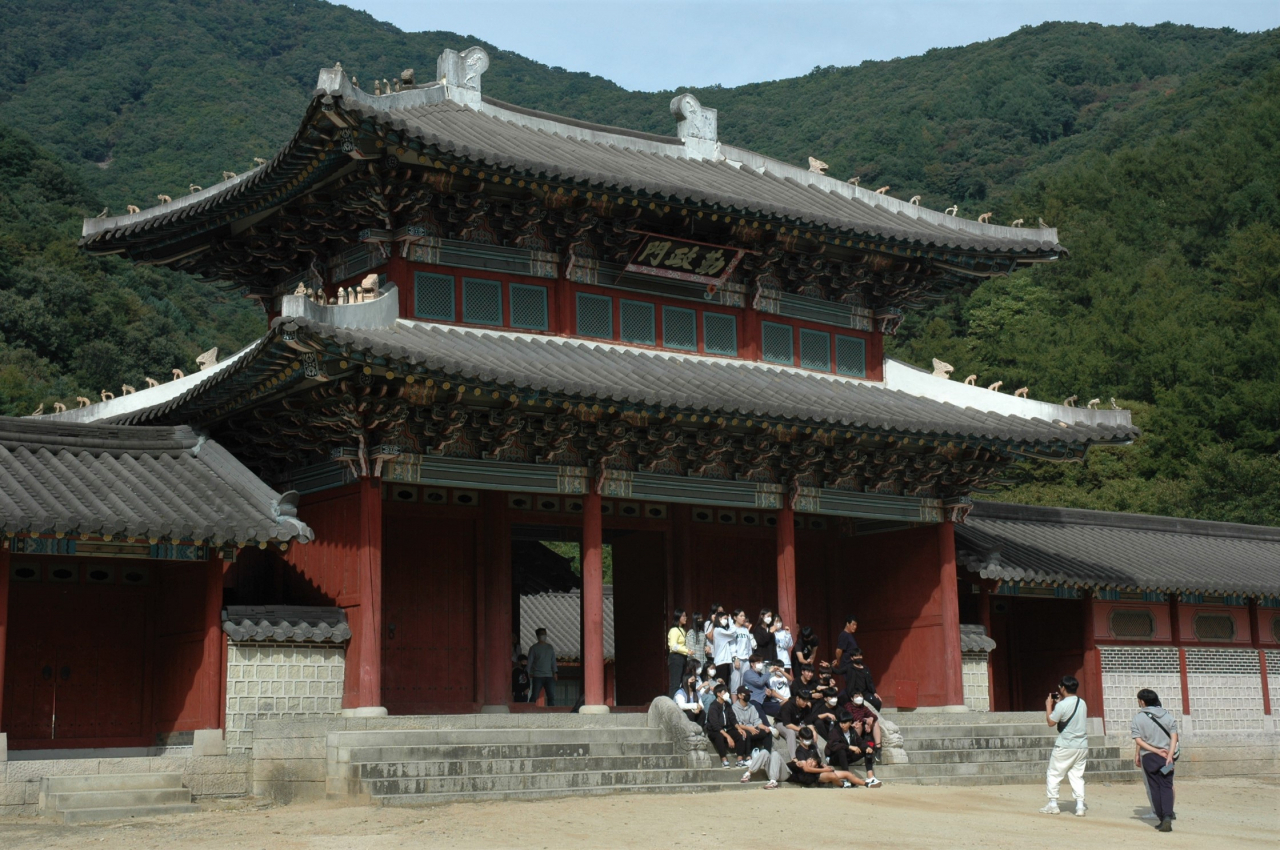Mungyeong promises a memorable time travel to the past
Korean period drama fans and hanok lovers can immerse themselves in the beauty of traditional Korean buildings at drama sets
Published : 2022-10-06 17:58:04

MUNGYEONG, North Gyeongsang Province -- The vast, sweeping road lined with ginkgo trees lend a magical quality to the walk through Mungyeongsaejae Pass, the historical road connecting the capital Hanyang (today’s Seoul) with the southeast corner of the peninsula.
Once Joseon Dynasty's most popular trail, it was the road taken by Confucian scholars from the southeastern part of the country on their way to the capital to take state exams. These days, visitors come to enjoy the beautiful natural scenery, including valleys, rivers, waterfalls and forests.


Visitors can now enjoy the area without masks as the crisp autumn air and fall foliage expected in mid-October signal peak hiking season.
A site that makes Mungyeongsaejae Pass more special is the Mungyeongsaejae Open Set, a drama set for filming Korean period dramas.
Mungyeongsaejae Open Set, some 2 1/2 hours drive southeast of Seoul, is a favorite filming set among television and film directors. From castle gates and palace buildings to the houses of noblemen and scholars and a commoners' village, different styles of the traditional Korean houses are tightly clustered in the area.

Near the entrance of Mungyeongsaejae Provincial Park, electric vehicles bring tourists to the set. A one-way ticket costs 2,000 won ($1.40) for adults, 800 won for teenagers and Korean soldiers, and 500 won for children.
“Though our electric vehicle offers a round trip service, many visitors decide to buy a one-way ticket to go to the drama set and choose to return to the park by walking the trail. People who are fit enough to enjoy trekking choose to feel the beautiful nature of Mungyeong to its fullest by walking,” a Mungyeongsaejae Pass official told The Korea Herald.
After paying admission fees for the drama set -- 2,000 won, 1,000 won and 500 won for adults, teenagers and Korean soldiers, and children, respectively -- the visitors will set foot on a dirt road leading back to the Joseon Dynasty.
The 70,000-square-meter open drama set is home to countless hit historical dramas and films, including KBS’ “The Slave Hunters" (2010), “The King’s Affection” (2021), MBC’s “Moon Embracing the Sun” (2012), “The Red Sleeve” (2021), SBS’ “Six Flying Dragons” and Netflix’s “Kingdom” (2020).


The houses, marketplace, forge and other traditional buildings offer good photo opportunities, while a hanok-style Starbucks awaits just a three-minute walk outside the Mungyeongsaejae Provincial Park. With its wooden interior design and small terrace, the Mungyeongsaejae Starbucks provides a blend of old and contemporary South Korean culture.

As a historical drama craze swept through the country in the early 2000s, the city additionally built the Gaeun Open Set for dramas that are set in the pre-Joseon era.
Located 17 kilometers south of Mungyeongsaejae Pass, Mungyeong Ecorala, a cultural theme park, contains Gaeun Open Set, which recreates the landscape of three ancient kingdoms -- Goguryeo, Baekje and Silla.
The set is a four-minute monorail ride from Mungyeong Ecorala’s entrance.
Most of the buildings and structures from the ancient Goguryeo Kingdom are found at the Filming Site 1, where the monorail stops.
Terrestrial broadcaster SBS’ 100-part smash-hit historical drama “Yeon Gaesomun” (2006-2007), which sheds light on the life of a powerful military figure in the waning days of the Goguryeo Kingdom, was shot here.

From thatched houses to inns and tile buildings, different lifestyles can be imagined from the architectural styles presented at the drama set.
Walking down the road from the reproduced Pyeongyang Castle for 10 minutes, both Filming Site 2 and 3 come into sight.
Surrounded by the mountain forest, ancient villages from Baekje and Silla Kingdoms present slightly different scenes from the first set, allowing the visitors to enjoy the blend of culture, history and nature.

An eco-themed park and Mungyeong Coal Museum offer interesting diversions, while Cafe Gaeun, housed in a converted train station, offers apple milk tea and iced apple latte as its signature drinks. Mungyeong is famous for its apples.


While many people fall in love with the cafe’s unique interior, which retains the characteristics of an old Korean train station, others enjoy their time taking photos in front of the scenic railroad, train station and splendid mountain background.
Admission to Mungyeong Ecorala costs 10,000 won and 9,000 won for adults and teenagers, respectively. Round trip tickets on the monorail are 1,000 won.
http://www.koreaherald.com/common/newsprint.php?ud=20221006000759